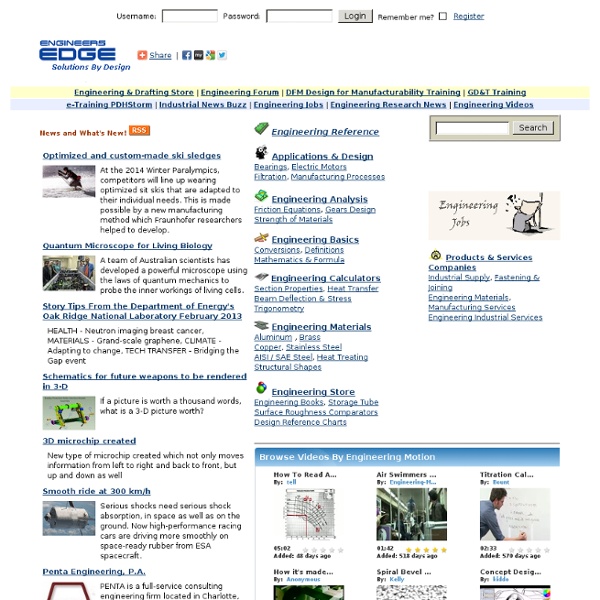O-ring
Typical O-ring and application The O-ring may be used in static applications or in dynamic applications where there is relative motion between the parts and the O-ring. Dynamic examples include rotating pump shafts and hydraulic cylinder pistons. Manufacturing[edit] O-rings can be produced by extrusion, injection molding, pressure molding or transfer molding.[1] History[edit]
Fluid bearing
They can be broadly classified into two types: fluid dynamic bearings and hydrostatic bearings. Hydrostatic bearings are externally pressurized fluid bearings, where the fluid is usually oil, water or air, and the pressurization is done by a pump. Hydrodynamic bearings rely on the high speed of the journal (the part of the shaft resting on the fluid) to pressurize the fluid in a wedge between the faces. Fluid bearings are frequently used in high load, high speed or high precision applications where ordinary ball bearings would have short life or cause high noise and vibration. They are also used increasingly to reduce cost.
Baking Pi - Operating Systems Development
This course has not yet been updated to work with the Raspberry Pi models B+ and A+. Some elements may not work, in particular the first few lessons about the LED. It has also not been updated for Raspberry Pi v2. Welcome to Baking Pi: Operating Systems Development! Course by Alex Chadwick. You can now help contribute to this tutorial on GitHub.
Rolling and Plain Bearings
Bearings for rotary motion are designed as rolling bearings or plain bearings. A distinction is drawn as to whether the forces occurring between the parts movable relative to each other are transmitted by rolling or sliding elements. Rolling bearingsRolling bearings generally comprise two bearing rings with integral raceways.
Gear Up! Top 10 Places to Find DIY Supplies
Home Depot, Michael’s, and other big-box stores are the go-to if you’re looking for a claw hammer or knitting needles, but what if you’re looking for an Erlenmeyer flask to use as a wine decanter? For just such cases, we created this bookmark-worthy list of web-based retailers that traffic in obscure tools and artisanal materials. Whether you’re a proto-Banksy looking for quality spray paint, a green-thumb on the hunt for exotic seeds, or a rookie robot-builder who needs a PCB, you’ll find what you need at one of these stores. Smooth-On What You Can Buy: Plastic molding supplies used for sculpture, props, architecture and more. Smooth-On makes hard plastics, soft rubbers, foams and novelty compounds that you can shape to match your creative vision.
80/20 Extrusion Goes Main Stream
We had to do a double take when we saw this kickstarter campaign video – and we bet you will too. It seem as if some company called [Infento Rides] took generic 80/20 aluminum extrusions and built a viable commercial product out of it – that’s not something you see everyday. 80/20 is meant to be something that engineers use to build things like test rigs and manufacturing fixtures. It’s not exactly an item designed for the consumer or end user. But we think the DIY/teaching aspect of this idea really has legs wheels.
Modern Machine Shop Blog
Blog This photo was taken by Todd Schuett of Creative Technology Corp. during Superior Tooling’s NCTAP orientation session back in March. The program’s stringent application process weeds out all but the most promising applicants before any commitment is made. A press release from Schunk recently caught my eye, but it didn’t have anything to do with the Morrisville, North Carolina, company’s workholding technology.
Electric linear actuator lead screws – article round-up
When it comes to specifying an electric linear actuator selecting the right lead screw* (sometimes referred to as the leadscrew) for the application is critical. That’s because the screw is the major drive component in most electric actuators. After all, if it’s not a belt-driven actuator, then there’s a lead screw involved. Lead screw types The choice of screw type can seem simple.
How to make 5S Stick
In my last post I detailed the 5S method (and its variants 4S, 6S, and so on). However, knowing the theory is the easy part. Successfully implementing 5S is much more difficult, and industry is ripe with anecdotes on failed 5S implementations. Here I will give you a few tips on how to increase your chances of success.
All About Stepper Motors
There are a wide variety of stepper types, some of which require very specialized drivers. For our purposes, we will focus on stepper motors that can be driven with commonly available drivers. These are: Permanent Magnet or Hybrid steppers, either 2-phase bipolar, or 4-phase unipolar. One of the first things to consider is the work that the motor has to do. As you might expect, larger motors are capable of delivering more power. Stepper motors come in sizes ranging from smaller than a peanut to big NEMA 57 monsters.
Keeping it together - Automotive Manufacturing Solutions
The benefits of replacing traditional body welds with adhesives, fixings and fasteners Not so long ago, the idea of using adhesive for body-in-white assembly operations would have been deemed unrealistic. However, slowly but surely, the numerous advantages of adhesives have ensured this innovative joining technique has made significant inroads into conventional methods of BIW construction. So what are the principal benefits? According to 3M, a Tier One expert in BIW joining techniques, these high modulus adhesive bonding systems exhibit high fatigue strength and demonstrate excellent stress distribution, a factor that increases the torsional stiffness of the car body, leading in turn to an improvement in the load/driving behaviour. Additionally, such products offer easy solutions to joining different materials, improved corrosion resistance, NVH benefits, reduced energy consumption and significant weight savings.



